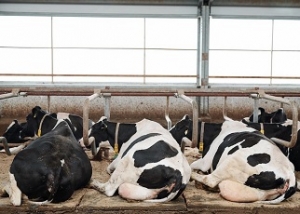Dairy in the World
Massive California Fire Creates New Challenges for These Dairy Farmers

Cricket Martin, a California dairy farmer, is thankful she has not been forced to evacuate. Neither has her 120-cow organic Holstein dairy. She and her husband, Connor, own and operate Martin Dairy in Scott Valley, Calif., where they also farm and graze around 400 acres.
While the McKinney fire currently does not pose a direct threat to their operation, the Martins are keeping a close eye on the nearby massive wildfire. They reported that with the help of rain over the last few days, firefighters were able to get closer to the fire to create some fire breaks.
“Dozer operators were able to create large fire breaks between the fire and Yreka (our closest, largest town),” Martin says. “The fire is now going southwest which is toward a less populated area of Siskiyou County called Happy Camp. It’s a small mountain town, with no agriculture there. It has created some new evacuation orders for that area.”
Optimistic, the Martins have not made an evacuation plan for their cattle. They feel their dairy is tucked in safely to hopefully escape the massive fire that is burning all around them. Martin Dairy borders right next to the helitack base, a small private airport that the U.S. Forest Service and Cal Fire helicopter staff with their helitack firefighters.
“We may be one of the safest locations in Scott Valley. The helitack base is hugely instrumental in fighting fires,” Martin adds. “Our ranch boarders right next to the base. It’s common every year to hear helicopters carrying water buckets overhead nonstop through the fire season. The helicopters will dip into local waterways and lakes and drop the water close to the fire lines. They also carry smoke jumpers.”
However, some areas where the Martins purchase their organic hay is under evacuation.
“Our hay supplier is safe,” she says. “Our area of Scott Valley is facing some major water curtailments which have been an ongoing and huge threat to our business.”
The Martins are thankful that their hay supplier has reserved hay for them through the winter, although they are unsure of what the cost is.
“If our hay supplier would have been devastated by the fire, I’m not sure that we could have afforded to purchase hay elsewhere because we are so rural,” she says. “We can feed our own cattle most of the winter months with our own hay produced.”
Grazing months in the Scott Valley area generally run from May to October.
Power On and Open Highways
Meanwhile, Bruno Hale, another California dairy farmer, has other worries. His biggest concern regarding the fire is to keep the main highways open to allow the milk truck and feed trucks to come in and out. Hale operates a 400-cow Organic dairy, plus an equal number of replacement heifers and custom raises an additional 500 heifers in Etna.
“As long as the main highways in this valley (Hwy 3 and 5) stay open, we’re good. If it closes down, I can’t hold more than three milkings worth of milk and I would then be forced to dump milk,” he says.
“So, we're just watching the fire. Some days we’re blue skies and other days we’re very smokey.”
Hale is also hoping that his dairy doesn’t lose power, especially in regards to irrigating his pastures and fields
“If this fire takes out the main power lines that would be a big blow,” Hale says. “Obviously, we have backup generators for the dairy, but I’ve got 200 acres of corn and another 600 acres of pasture that we’re trying to keep green, so if the power goes down for a long period, we can’t turn on the irrigation wells, so that becomes a big issue.”























